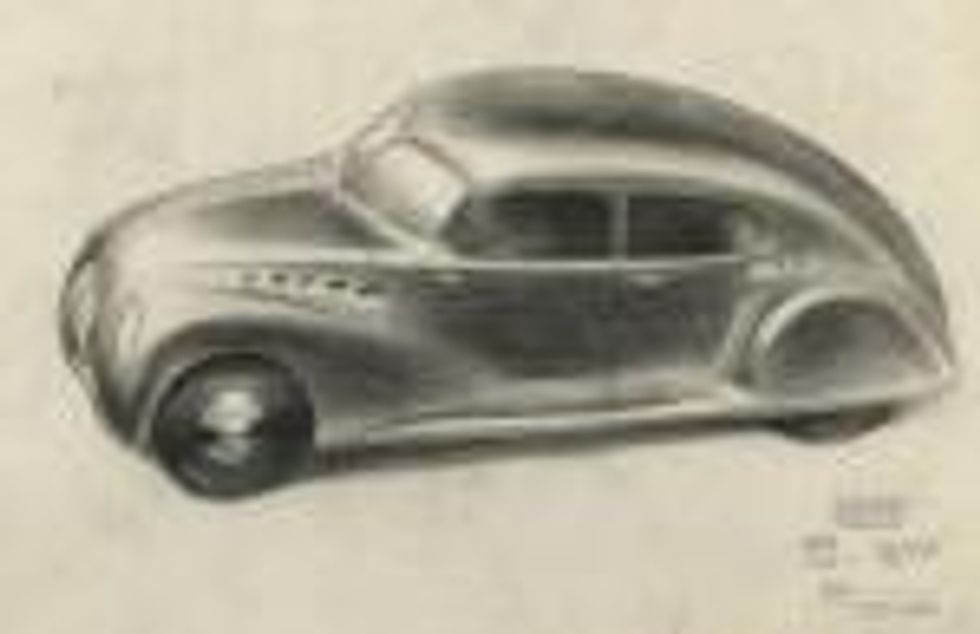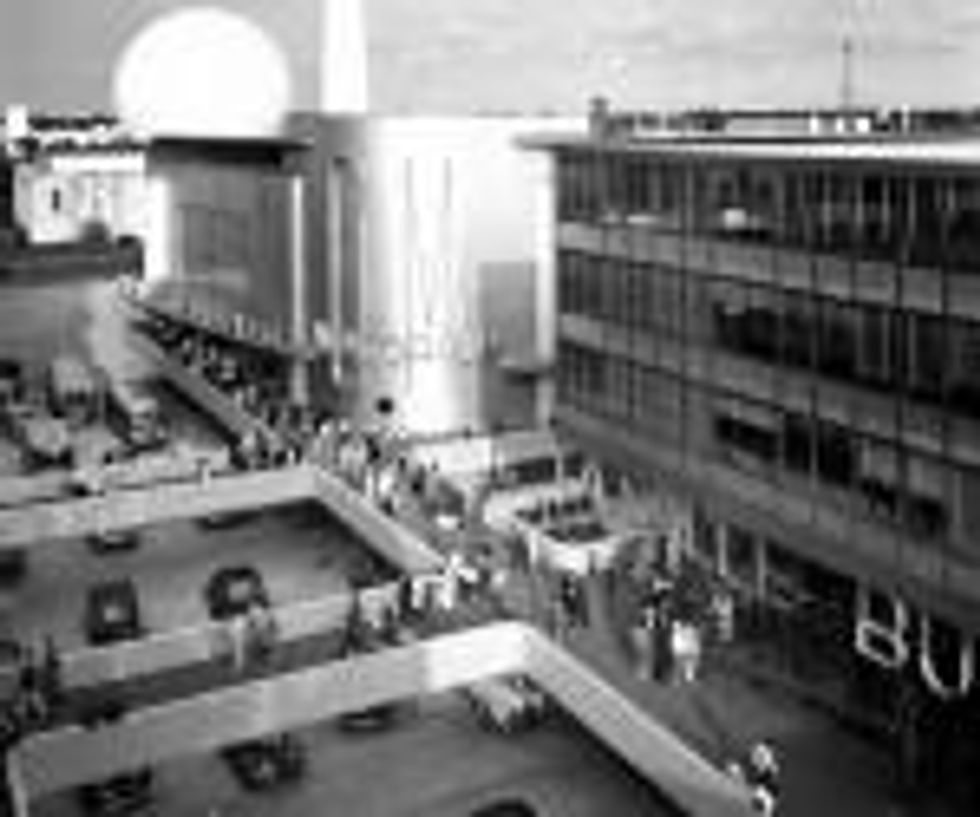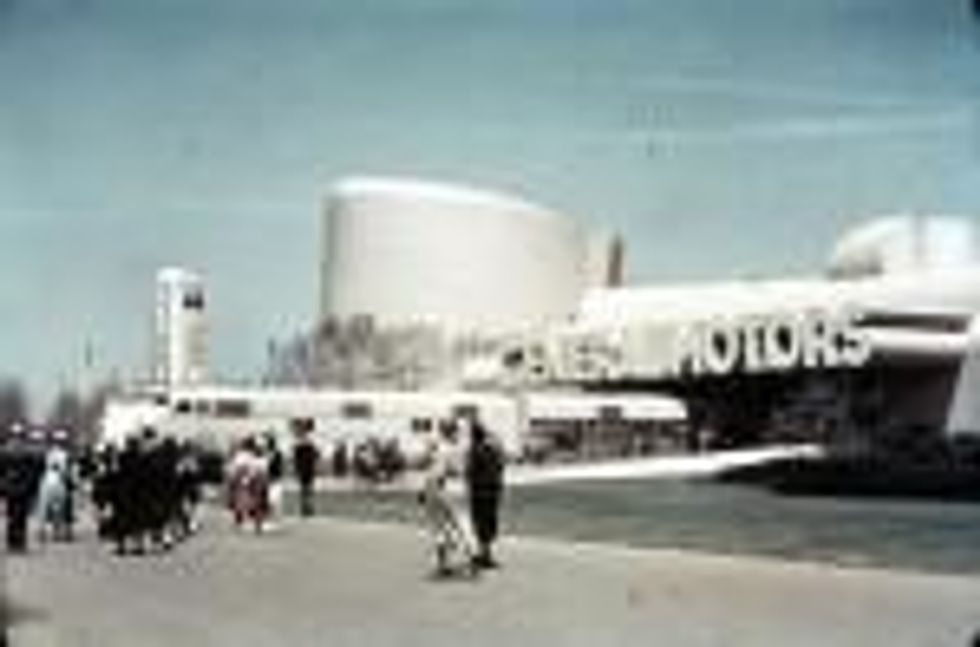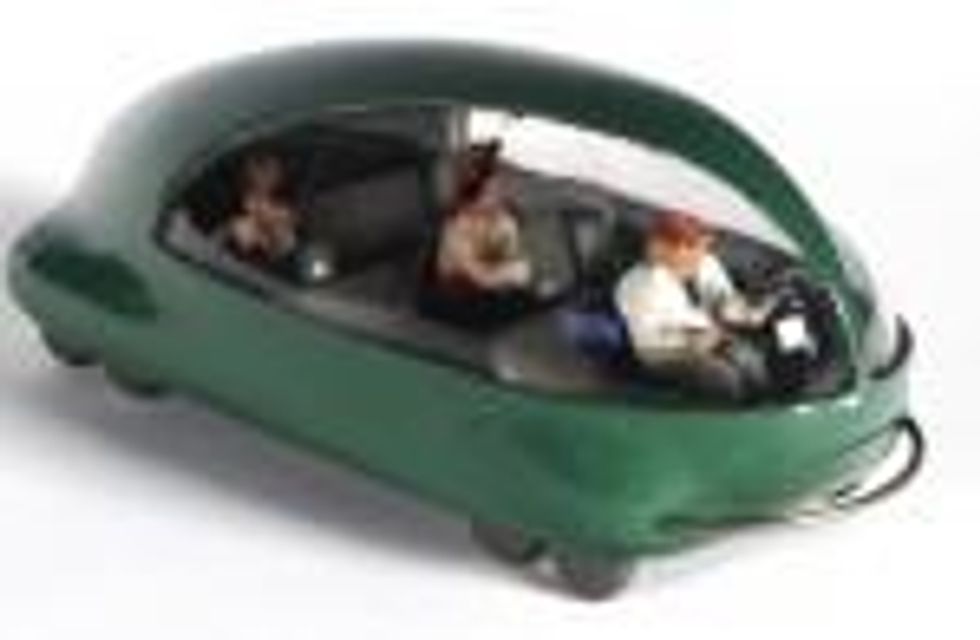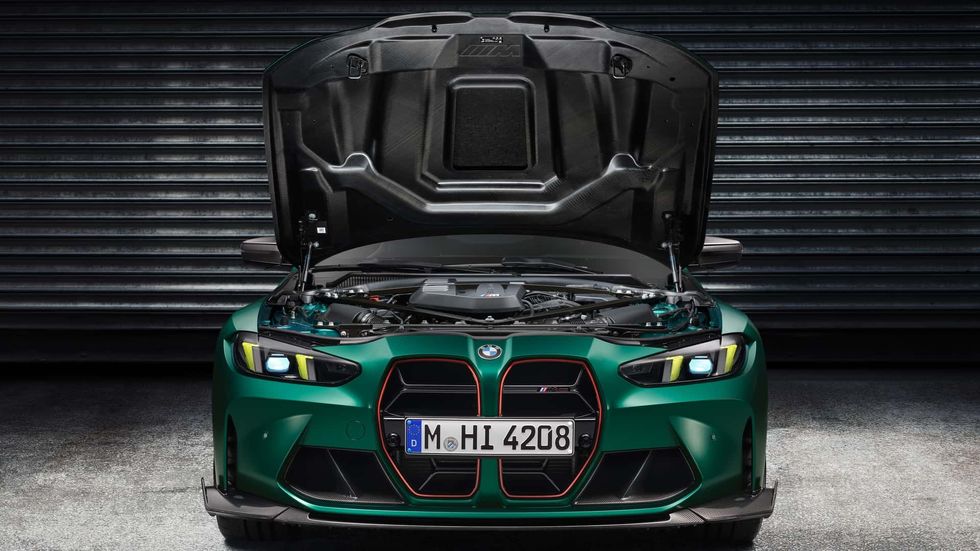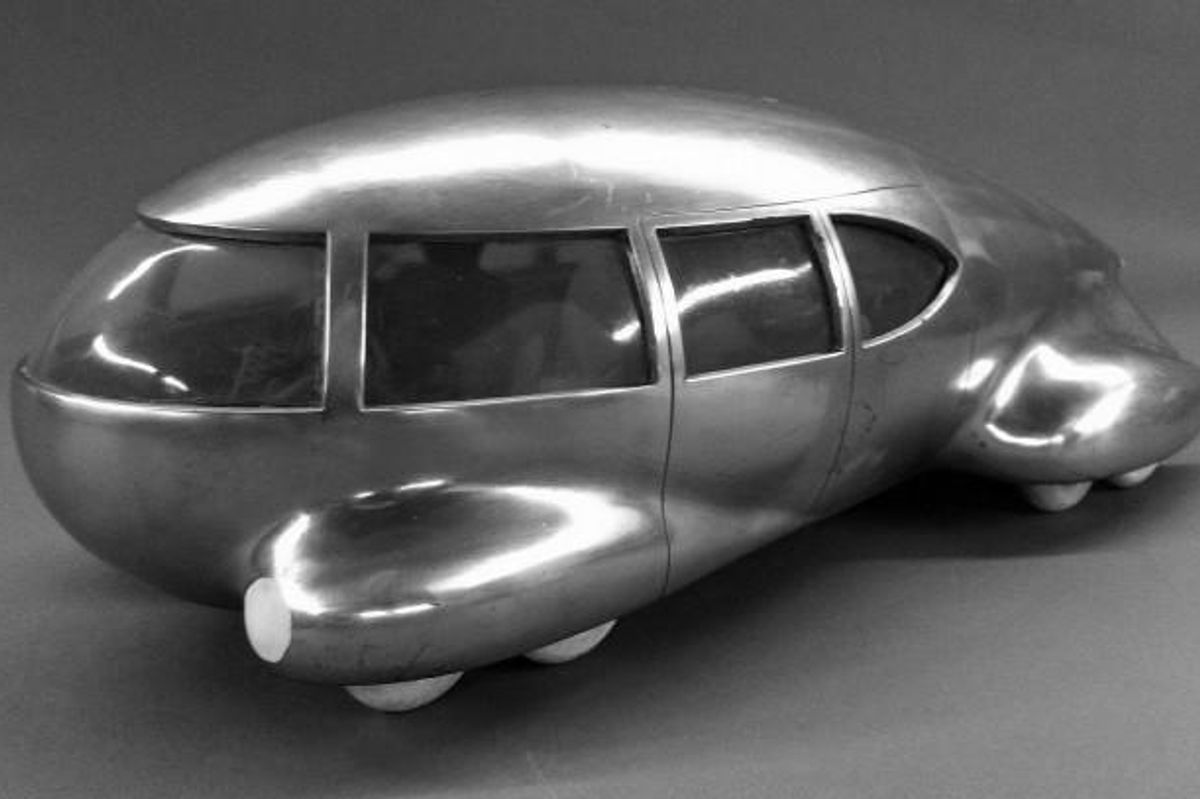
Buy
Resources
Entertainment
Magazine
Community
In This Article
Category:
Automobilia
Norman Bel Geddes's teardrop car model. Photo by A. Van Dyke.
Norman Bel Geddes didn't design a single vehicle that entered production. He didn't hold down any job with an automaker for more than a few years, and in fact, he much preferred designing theater sets over designing anything else, cars included. Yet he proved immeasurably influential to automotive and transportation design, warranting a new exhibit that traces his career and legacy.

Much like a couple of his contemporaries, Buckminster Fuller and Frank Lloyd Wright, Norman Bel Geddes envisioned not just snippets of potential futures, but an overarching and unified future where architecture and planned communities integrated with industrial design and transportation. He began to express those ideas in 1927 when, after finding success at stage design and after finding the boxy cars and trucks of the day disappointing, he designed a number of futuristic vehicles, some of the earliest ones to apply engineers' ideas on streamlining to car bodies here in the States, leading many to label Bel Geddes as the father of the term "streamlining."
(We should note here that others - most notably Paul Jaray, Edmund Rumpler, and Dennis Burney - had explored streamlining as it applies to automobiles before Bel Geddes, but it was Bel Geddes's long and flowing lines that brought an aesthetic sense to the field and that set the mold for futuristic car designs for the next few decades.)
As Michael Lamm wrote in Special Interest Autos #40, May-July 1977, those automotive designs caught the attention of Graham-Paige's Ray Graham, who hired Bel Geddes the following year as a styling consultant and tasked him with designing the Graham-Paige of 1933 and working backwards from that design year by year to allow the company to incrementally work toward Bel Geddes's radical designs. The onset of the Depression the following year would derail those grand plans, but Bel Geddes stayed on with Graham-Paige until Ray Graham's death in 1932.
Bel Geddes followed that stint with his 1932 book Horizons, in which he articulated his ideas on automobile design, arguing that engines should drive the car from the rear, that drivers should sit up front and center for a commanding view of the road, and that automobiles should ride on six or eight wheels instead of four, echoing Milton O. Reeves's assertions of a couple of decades prior. Along with the book, he built another set of models, which this time caught the attention of Walter P. Chrysler, who in 1933 invited Bel Geddes to submit some proposals for a compact car and some improvements and spin-offs of the Chrysler Airflow.
He followed that contract with work for Autocar (focused on making the company's trucks look more powerful) and Texaco (designing the Doodlebug Diamond T fuel oil delivery trucks) before approaching Shell in 1937 with a plan to develop his vision for a city of the future, which used superhighways to keep traffic moving through and above cities. While Shell funded Bel Geddes's model for an advertising campaign, he nevertheless approached General Motors with it, convincing Alfred Sloan to let him develop it for GM's pavilion at the upcoming 1939-1940 New York World's Fair.
Photos via GM, Library of Congress, Rich701, Harry Ransom Center.
Though it ended up costing GM $7 million - or as much as $237 million in today's dollars - the resulting Futurama exhibit proved a hit for GM, with lines snaking around the building waiting for a chance to see Bel Geddes's elaborately executed vision for the cities and highways of 1960. The layout encompassed an entire acre and included half a million individual buildings, a million individual trees of 13 species, 50,000 cars (all, naturally, rear-engined streamliners with a multitude of wheels), and a 14-lane interstate highway that separated traffic out according to speed and destination while at the same time accommodating urban pedestrian traffic. As Adnan Morshed of the National Air and Space Museum wrote in The Aesthetics of Ascension in Norman Bel Geddes's Futurama:
the Futurama aspired to be the culmination of early-twentieth-century urbanist thinking. (It) prophesied an American utopia regulated by an assortment of cutting-edge technologies: remote-controlled multilane highways, power plants, farms for artificially produced crops, rooftop platforms for individual flying machines and autogyros, and various gadgets, all of which were intended to create an idea built environment and, ultimately, to reform society.
Visitors sat on a conveyor belt and looked down on the spectacle from above, taking an 18-minute narrated tour as if they flew above the landscape. The end of the tour then dropped them off at a full-scale street intersection as envisioned by Bel Geddes, complete with passenger flyovers and GM cars and trucks comprising the "traffic" below. Tens of thousands of visitors took in Bel Geddes's Futurama every day - estimates range from about 10 million to 25 million overall - making it the fair's most visited attraction.
"Futurama's giant model of America in 1960, complete with glass-clad skyscrapers and multilevel superhighways, gave Depression-era Americans genuine hope for a better future within their lifetimes," Donald Albrecht wrote in Norman Bel Geddes Designs America. "It was Geddes, more than any designer of his era, who created and promoted a dynamic vision of the future with an image that was streamlined, technocratic, and optimistic. Today, as seen in the 'retro-futurist' looks of theme parks, animated television programs, and popular novels, Geddes's vision of the future continues to shape and inspire the twenty-first-century American imagination."
One would have thought that Bel Geddes would have parlayed such a success into a career in automotive or transportation design, but apart from a two-year contract for Nash, a 1940 design for a streamlined tank, and an assignment to design delivery and sales trucks for IBM, Bel Geddes remained largely involved in theater set design until his death in 1958.
Today, Bel Geddes's archives reside at the Harry Ransom Center at the University of Texas at Austin, which in the fall of 2012 assembled about 200 of Bel Geddes's drawings, models, photographs, and films for I Have Seen the Future: Norman Bel Geddes Designs America, an exhibit that, according to the Harry Ransom Center's blog, "highlights Bel Geddes's creativity and desire to transform American society through design." The exhibit then traveled to the Museum of the City of New York from last October through this February and has now gone to the Wolfsonian at Florida International University in Miami Beach.
"Geddes was both a visionary and a pragmatist who had a significant role in shaping not only modern America, but also the nation's image of itself as leading the way into the future," Albrecht wrote. "Underlying Geddes's amazing array of efforts were themes that can be traced throughout his career: his commitments to the power of unfettered imagination and the primacy of the individual, his fascination with nature as a model for imitation, and his belief in the possibility of a utopian future. And Geddes's showmanship became his trademark."
I Have Seen the Future will run through September 28 at the Wolfsonian. For more information, visit Wolfsonian.org.
Recent
Photo: John Gilbert
Smack dab in the heartland of America, Enid, Oklahoma is an exceptionally friendly small town with a triad of great car shows that occur in three consecutive weekends. The fun starts with the Boy Scouts Show, which is always the last Saturday in March, then the Corvette Expo on the first weekend of April. For 2024, there is a newcomer to Enid’s car show scene: the Shepherds Show & Shine, which lands on the second Saturday in April.

Harold Clay, owner of Clay’s Collision Center and Harold’s Hot Rod Shop in Enid, called me at home in California and asked if I could offer our mutual friend Tom’s daughter some tips on how to put on a charity car show for her church (St. Paul’s Lutheran Church and School) for its first attempt. I’m in Enid several times a year, so I knew the Boy Scouts car show is traditionally held on the last Saturday in March followed by the Corvette Expo always on the first Saturday in April. I Googled to see if April 13th was okay to hold Shepherds 1st Annual Custom & Classic Car Show & Shine and it looked like the coast was clear.

Famous last words. On January 28, 2024, I posted Shepherds Show & Shine flyer on Clay’s Collision Center’s Facebook page to help promote the new show. Immediately the proverbial poop hit the fan. Folks had misread the flyer and erroneously thought Clay’s Collision Center was the promoter of Shepherds show, so Clay’s phone started ringing off the hook with people asking for show information. Who knew Easter would fall on March 30, 2024? I couldn’t find it announced anywhere online that the Boy Scouts Show had moved their date from late March to April 13, 2024, one week after the 32nd Annual Corvette Expo came to Enid.

The wheels were motion and it appeared that neither party would back out, so consequently both car shows were set to take place on the same day. The early morning of April 13 started out a little stressful and then as the morning progressed plenty of cars, pickups and motorcycles started rolling into Shepherds 1st Annual Custom & Classic Car Show & Shine. A great success, the Shepherds show was an absolute nostalgic time warp. St. Paul’s church was built in 1926 and the beautiful old houses in the neighborhood circa 1927 set the mood. It was a good scene, the adjacent fenced schoolyard to the car show grounds was packed with children playing and dogs on leashes were everywhere… classic rock ’n roll music filled the air.

At 1:30pm Harold and I jumped into his chop-top ’60 Chrysler New Yorker and headed over to the Boy Scouts show that was hosted by the Enid Antique Auto Club at the Chisholm Trail Expo Center. Just like the Shepherds Show & Shine, admission for spectators at the Boy Scouts Show was free to all. Interestingly, the cars shown indoors at the Boy Scouts Show were mostly of a different style than the cars that rolled into Shepherds Show & Shine held outdoors, so the number of show cars was high at both locations. And Harold and I noticed a lot of the spectators we spotted at Shepherds were also present at the Boy Scouts Show, so apparently all that is well, ends well.
Shepherds Show & Shine/Boy Scouts Show - Highlights
Photo: John Gilbert
Kathy Burge’s 302-powered 1976 Ford Bronco has been in the family since purchased brand new.






Keep reading...Show Less
BMW
BMW’s inline-six engine will live on through another model year in the 2025 BMW M4 CS, the German automaker’s latest track monster. The lightweight coupe is turbocharged to hit 543-horsepower and is slathered in carbon fiber-reinforced plastics for additional strength and weight savings.
The 2025 BMW M4 CS will reportedly sport the S58 inline-six-cylinder engine under the hood, the same engine that powers the M4 GT3 race car that driver Sheldon van der Linde earned his first winning title in during the 2022 Deutsche Tourenwagen Masters (DTM) Championship. BMW states that it cranked up the turbos in the M4 CS to 30.5 psi, which gives it 20 more horsepower when compared to the M4 Competition Coupe. A maximum 479 pound-feet of torque hits all four wheels via an eight-speed automatic transmission, while a 7,200 rpm redline encourages high-revving, spirited driving.
An active M differential automatically shifts power to the outside wheel in tight turns and also counteracts with the loss of traction during high-speed lane changes. In addition, BMW’s intelligent xDrive AWD system uses your driving data to automatically relay power to individual wheels for optimal traction and control.
In the new production model, cooling is further improved by using a 3D-printed cylinder head core. BMW also updated the oil system for better lubrication, which is said to provide more consistency when hitting high revs and driving around quick, tight corners. Speaking of racing around fast corners, BMW implemented plenty of chassis reinforcements for responsive handling. Further supporting superior handling is an M4 CS-specific adaptive M suspension system which offers adjustable damping settings. The forged alloy wheels can be wrapped with track tires or ultra-track tires at no additional cost.
BMW says the G82 M4 CS has a curb weight of 3,902-pounds; 77 pounds lighter than the M4 Competition xDrive. To achieve such a weight savings, the automaker used carbon fiber and carbon fiber-reinforced plastic on as many components as possible, including the full-carbon roof and carbon-plastic hood, front air intakes, mirror caps, rear diffuser, and rear spoiler. Eight pounds was dropped from the exhaust system by utilizing a titanium muffler.
For the 2025 BMW M4 CS’s interior, BMW wrapped the steering wheel in Alcantara leather and fitted the driver and passengers with tight-fitting M Carbon Bucket Seats upholstered in Merino leather. A 12.3-inch digital gauge cluster and 14.9-inch touchscreen displays all the information the driver needs via BMW’s iDrive 8.5 infotainment software.
BMW is on schedule to start building the 2025 M4 CS in July 2024 in Dingolfing, Germany. The 2025 BMW M4 CS is said to start at $124,675.
Keep reading...Show Less






